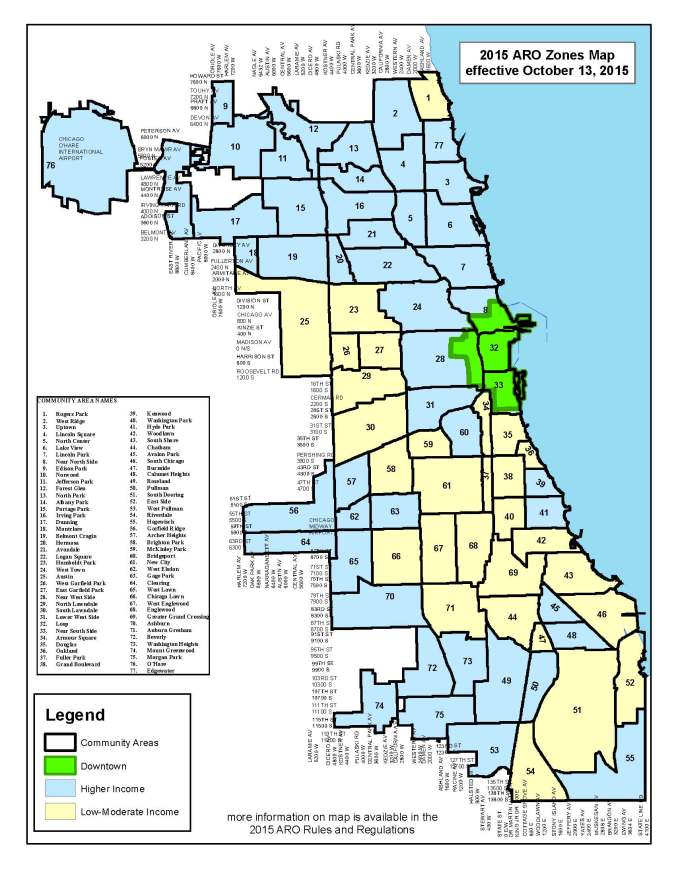By: Charles Dabah
Since its adoption in 2003, Chicago’s Affordable Requirements Ordinance (ARO) has been an important mechanism for the creation of affordable rental and for-sale housing in private-market developments. Developments subject to the ARO are required to set aside 10% of units to be built as affordable housing, with projects receiving financial assistance from the City required to make 20% of the units affordable. Developers who want to opt out of building the affordable units can pay an in-lieu fee of $100,000 per required unit, most of which will go toward future construction of affordable housing.
However, over the past decade, Chicago has failed to create enough new affordable units to keep pace with the loss of affordable housing around the city. A common critique of the current ARO is that the in-lieu fee is not set high enough. Citing rising development, construction and land costs, especially in higher income areas, developers often choose to pay the in-lieu fee over building affordable units.
A makeover of the ARO is the latest mayor-led initiative to try to shore up the city’s affordable housing stock. This will significantly change the fee structure for developers who opt out of building the affordable units required under the ordinance. In March 2015 the City Council approved the updates, and all projects that are submitted on or after today, October 13, 2015, will follow the rules and regulations of the new ARO.
At the core of the changes to the ARO is the development of a new zone map, which divides the physical area of the city into one of three zones: 1) downtown; 2) higher-income areas; and 3) low-moderate income areas. The ARO defines downtown areas by the boundaries of the “D” zoning districts in accordance with the Chicago Zoning Ordinance. Higher income areas are census tracts that are higher income (50% of households or more earn more than 60% of the Chicago median income in two of the last three years for which data is available) AND low poverty (the poverty rate is less than or equal to 25% in two of the last three years for which data is available). Low-moderate income areas are census tracts that are lower income (more than 50% of households earn less than 60% of the Chicago median income in two of the last three years for which data is available) OR high poverty (the poverty rate is greater than 25% in two of the last three years for which data is available).
The three zone map options that were under consideration were:
- Option 1: The zone map is divided up by census tract (the exception being Downtown), with each census tract being designated either Downtown, higher-income, or low-moderate income.
- Option 2: The zone map is divided up by community area (the exception being Downtown), with each community area being designated higher-income or low-moderate income based on the total number of households in higher-income census tracts within a community area versus total number of households in low-moderate income census tracts within a community area. For example, if a greater number of households reside in higher-income census tracts within a given community area, the community area would be designated higher-income on the zone map.
- Option 3: The zone map is divided up by community area (the exception being Downtown), with each community area being designated higher-income or low-moderate income based on total area of higher-income census tracts versus total area of low-moderate income census tracts. For example, if a community area is taken up by a greater physical area of higher-income census tracts, the community area would be designated higher-income on the zone map.
The City’s Department of Planning and Development selected Option 3, pictured above. The zone map is an important modification to the ARO, and geographic and demographic characteristics will play more critical roles in the structure and outcomes of the policy. Given that the characteristics of Chicago community areas are part and parcel of the new ARO framework, what does this mean for future development on the community area level?
The Lower West Side (Pilsen) was one of seven community areas in Chicago that would have had a different zone designation between Option 2 and Option 3. According to the criteria for Option 2 Pilsen is a low-moderate income area, and for Option 3 it is a higher income area. With the City’s selection of Option 3, developers will be required to pay an in-lieu fee of $125,000 per unit for every required affordable unit that they do not build, compared to $50,000 per unit if Option 2 had been selected. Two other community areas that are experiencing increases in developer investment, Uptown and Pullman, had the same zone designations as Pilsen for Options 2 and 3 and developers will have to pay a higher in-lieu fee as a result of the selection of Option 3.
The full implications of new changes to the ARO will not be known for a while. Will the new tiered system for in-lieu fees help to generate more affordable housing in higher opportunity areas? As home values rise and Pilsen and other desirable neighborhoods continue to develop at a rapid pace, it will be interesting to see if and how amendments to the ARO might begin to close the gap between demand for and supply of affordable housing.

Thank you for this clearly-written article. In addition to Pullman, Pilsen, and Uptown, which other community areas (if any) would have had a lower zone designation if they had been classified under Option 2?
LikeLike
Hi Noreen,
Thank you for your comment. The Near West Side and West Pullman also would have had lower zone designations under Option 2. McKinley Park and East Side would have had higher zone designations under Option 2. All other community areas have the same zone designation under Options 2 and 3.
LikeLike
Pingback: Transformed? Public Housing in Chicago 2000-2015 | the voorhees center for neighborhood & community improvement